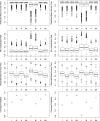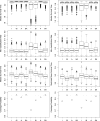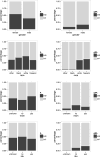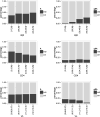DOUBLY ROBUST ESTIMATION OF OPTIMAL TREATMENT REGIMES FOR SURVIVAL DATA-WITH APPLICATION TO AN HIV/AIDS STUDY
- PMID: 29308102
- PMCID: PMC5749433
- DOI: 10.1214/17-AOAS1057
DOUBLY ROBUST ESTIMATION OF OPTIMAL TREATMENT REGIMES FOR SURVIVAL DATA-WITH APPLICATION TO AN HIV/AIDS STUDY
Abstract
In many biomedical settings, assigning every patient the same treatment may not be optimal due to patient heterogeneity. Individualized treatment regimes have the potential to dramatically improve clinical outcomes. When the primary outcome is censored survival time, a main interest is to find optimal treatment regimes that maximize the survival probability of patients. Since the survival curve is a function of time, it is important to balance short-term and long-term benefit when assigning treatments. In this paper, we propose a doubly robust approach to estimate optimal treatment regimes that optimize a user specified function of the survival curve, including the restricted mean survival time and the median survival time. The empirical and asymptotic properties of the proposed method are investigated. The proposed method is applied to a data set from an ongoing HIV/AIDS clinical observational study conducted by the University of North Carolina (UNC) Center of AIDS Research (CFAR), and shows the proposed methods significantly improve the restricted mean time of the initial treatment duration. Finally, the proposed methods are extended to multi-stage studies.
Keywords: Doubly robust estimation; median survival time; optimal treatment regimen; restricted mean survival time.
Figures





Similar articles
-
On optimal treatment regimes selection for mean survival time.Stat Med. 2015 Mar 30;34(7):1169-84. doi: 10.1002/sim.6397. Epub 2014 Dec 16. Stat Med. 2015. PMID: 25515005 Free PMC article.
-
Concordance-Assisted Learning for Estimating Optimal Individualized Treatment Regimes.J R Stat Soc Series B Stat Methodol. 2017 Nov;79(5):1565-1582. doi: 10.1111/rssb.12216. Epub 2016 Oct 31. J R Stat Soc Series B Stat Methodol. 2017. PMID: 29358898 Free PMC article.
-
Doubly robust estimation of optimal dynamic treatment regimes with multicategory treatments and survival outcomes.Stat Med. 2022 Oct 30;41(24):4903-4923. doi: 10.1002/sim.9543. Epub 2022 Aug 10. Stat Med. 2022. PMID: 35948279
-
Comparison of dynamic treatment regimes via inverse probability weighting.Basic Clin Pharmacol Toxicol. 2006 Mar;98(3):237-42. doi: 10.1111/j.1742-7843.2006.pto_329.x. Basic Clin Pharmacol Toxicol. 2006. PMID: 16611197 Review.
-
A simple, doubly robust, efficient estimator for survival functions using pseudo observations.Pharm Stat. 2018 Feb;17(1):38-48. doi: 10.1002/pst.1834. Epub 2017 Nov 1. Pharm Stat. 2018. PMID: 29094501 Review.
Cited by
-
A general framework for subgroup detection via one-step value difference estimation.Biometrics. 2023 Sep;79(3):2116-2126. doi: 10.1111/biom.13711. Epub 2022 Aug 2. Biometrics. 2023. PMID: 35793474 Free PMC article.
-
Estimation of optimal treatment regimes with electronic medical record data using the residual life value estimator.Biostatistics. 2024 Oct 1;25(4):933-946. doi: 10.1093/biostatistics/kxae002. Biostatistics. 2024. PMID: 38332633 Free PMC article.
-
Selection of the optimal personalized treatment from multiple treatments with right-censored multivariate outcome measures.J Appl Stat. 2023 Jan 10;51(5):891-912. doi: 10.1080/02664763.2022.2164759. eCollection 2024. J Appl Stat. 2023. PMID: 38524800 Free PMC article.
-
Joint modeling and multiple comparisons with the best of data from a SMART with survival outcomes.Biostatistics. 2022 Jan 13;23(1):294-313. doi: 10.1093/biostatistics/kxaa025. Biostatistics. 2022. PMID: 32659784 Free PMC article.
-
Optimal treatment regimes for competing risk data using doubly robust outcome weighted learning with bi-level variable selection.Comput Stat Data Anal. 2021 Jun;158:107167. doi: 10.1016/j.csda.2021.107167. Epub 2021 Jan 14. Comput Stat Data Anal. 2021. PMID: 33994608 Free PMC article.
References
-
- Chen PY, Tsiatis AA. Causal inference on the difference of the restricted mean lifetime between two groups. Biometrics. 2001;57:1030–1038. MR1950418. - PubMed
-
- Cox DR. Regression models and life-tables. J Roy Statist Soc Ser B. 1972;34:187–220. MR0341758.
-
- Dombrowski JC, Kitahata MM, Rompaey SEV, Crane HM, Mugavero MJ, Eron JJ, Boswell SL, Rodriguez B, Mathews WC, Martin JN, Moore RD, Golden MR. High levels of antiretroviral use and viral suppression among persons in HIV care in the United States, 2010. J Acquir Immune Defic Syndr. 2013;63:299–306. - PMC - PubMed
-
- Gill RD, Keiding N, Andersen PK. Statistical Models Based on Counting Processes. Springer; New York: 1997.
Grants and funding
LinkOut - more resources
Full Text Sources
Other Literature Sources
